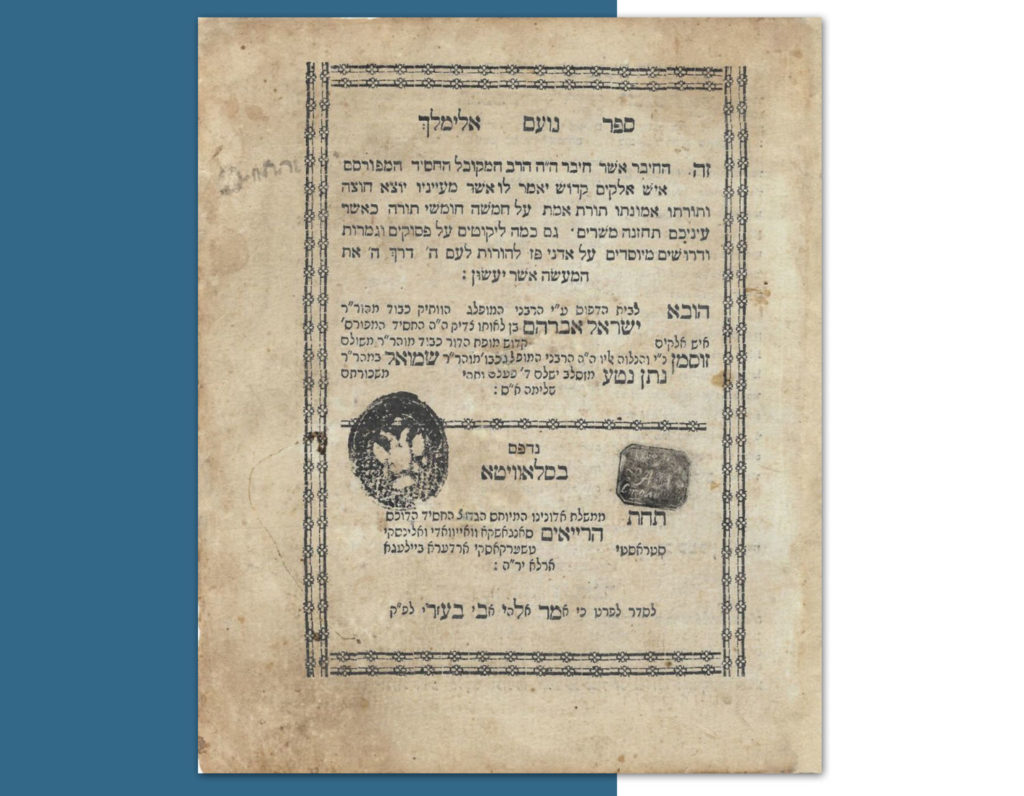
Noam Elimelech – Slavuta edition. Chassidic essays on the Torah by the Rebbe Rabbi Elimelech of Lizhensk, with ‘Likkutei Shoshanah’ and ‘Iggeret HaKodesh.’ Holy book, printed in sanctity by the Admo”r Rabbi Moshe Shapira. Slavuta, 1794. Before us is the second most important edition, after the first edition.
The Slavuta edition before us was brought to print by the Admo”r Rabbi Yisrael Avraham, Av Beit Din of Chorny-Ostrov – one of the leading Admo”rs of his generation, son of Rabbi Zusha of Anipoli, and nephew of the author, Rabbi Elimelech of Lizhensk. Also appearing here for the first time is the approbation from his father, Rabbi Zusha of Anipoli, the author’s brother. The foreword by the son of Rabbi Elimelech of Lizhensk, the Admo”r Rabbi Elazar Weissblum, is printed after the approbations, considered by Admo”rs “almost like the whole book of Noam Elimelech .” (See discussion below.)
There are three important approbations from Chassidic leaders on the back of the title page, including an approbation by Rabbi Ya’akov Shimshon of Shpitovka. He mentions the printer’s name, Rabbi Moshe Shapira, in his approbation: “The exalted rabbi, the complete sage, Rabbi Moshe, son of … Rabbi Pinchas.” (The printer’s name is not written on the title page.)
The Rebbe Rabbi Elimelech of Lizhensk [1717-1787] was considered the Admo”r of the Admo”rim (or, as the Chassidim express it, the Rebbes’ Rebbe). His disciples include leading Admo”rs: the seer of Lublin, the maggid of Kozhnitz, Rabbi Avraham Yehoshua Heschel of Apta, Rabbi Isaac of Kaliv, Rabbi Mendel of Rimanov, and many others. He was related to as one of the lofty seraphim, to the point that the Chassidic tzaddikim would say that there is a special gehinnom for those who do not add the title “The Rebbe” before Rabbi Elimelech’s name. They would also say that one of the questions Mashiach will ask will be “Did you support the grandchildren of Rabbi Elimelech of Lizhensk?” And the Admo”rs would practice this as halachah, and give respectably to any of his descendants who would chance by them. Those of his descendants who are in need benefit accordingly to this day. When there is a mass gathering at his grave site in Lizhensk on 21 Adar, his grandchildren stand mentioning the above saying and receive respectable gifts from those who arrive to prostrate themselves at his grave.
The book Noam Elimelech is the most important Chassidic book of all time. It is considered a segulah book, and it is also printed in miniature editions – like the book Raziel HaMalach – to be used as an amulet. Another tried-and-true ancient segulah is to put it under the head of a woman giving birth as a segulah for an easy birth. The maternity wards at the hospitals regularly have copies of Noam Elimelech to offer to women having difficulty during their births. Leading Admo”rim frequently mention this book in their works, including Rabbi Avraham Yehoshua Heschel of Apta; Rabbi Kalonymus author of Me’or VaShemesh , and others. Rabbi Nachman of Breslov said: “Rabbi Elimelech’s sanctity is at a lofty exalted level, more than what can be seen and discerned from his book.” ( Chayei Mohara”n ). Rabbi Mendel of Rimanov, a leading Admo”r of Galicia, said that only after he had immersed in a mikveh before the onset of Shabbat was he able to understand anything in Noam Elimelech . Rabbi Heschel, Av Beit Din of Talust said: Whoever can comprehend this book has the ability to revive the dead. The Ba’al HaTanya called it “The Book of Tzaddikim” (while calling his own book, Tanya , “The Book of the Mediocre”). He added, “Not every mind can endure it.”
The edition before us, despite its chronologically being the third edition, is considered the second edition in terms of its importance – both for its segulah value and its material value – after the first edition (which is currently priceless). This is for the following reasons: First, the one who brought it to print was, as mentioned, Rabbi Zusha of Anipoli’s son, who was also the nephew of Rabbi Elimelech of Lizhensk, and was himself one of the leading Admo”r’s of his generation, to the extent that his father, Rabbi Zusha of Anipoli, said that his soul was that of King Chizkiyahu of Yehudah. This was none other than the Admo”r Rabbi Yisrael Avraham, Av Beit Din of Chorny-Ostrov. He passed away at a young age and was succeeded by his widow in leading the Chassidim – a unique case, unparalleled in the annals of Chassidism. Her in-law, the Admo”r Rabbi Mordechai of Chernobyl, participated at a tisch she ran during the time “Rava D’Ravin” at the third Shabbat meal. Another reason is the press at which this edition was printed – that of the Admo”r Rabbi Moshe Shapira (who is described by Rabbi Shneur Zalman of Liadi as: “The rabbi, the luminary, famous and exalted in Torah and Divine reverence) – rabbi of Slavuta, and son of Rabbi Pinchas of Koritz. At the Slavuta press, even the printing tools and letters were immersed in a mikveh before beginning the work. Therefore, books that were printed there are known for their sanctity and are a special segulah for protection and success. Another reason is that in the edition before us, the approbation from Rabbi Zusha of Anipoli, older brother of the author, appears for the first time. It is known that the name “Noam” in the title of the book Noam Elimelech is Rabbi Zusha’s name (the Hebrew translation of the Yiddish “Zusha” is Noam). Another reason is the foreword by the son of the Rebbe Rabbi Elimelech of Lizhensk – the Admo”r Rabbi Elazar Weissblum, who writes interesting expressions of prayer and blessing in his words: “… for the sake of the honor of Your Name, please fulfill these blessings which were always in my father’s mouth, with which he would bless the Jewish people and devote himself to them at all times, to cancel evil decrees with his faithful prayers and devotion … as You were with my father zlh”h, please be with me, and with my brothers and friends beloved to my soul.” This important foreword was omitted from some of the subsequent editions. Ohel Shlomo relates that this foreword was especially beloved to the Admo”r, the author of Tiferet Shlomo of Radomsk “almost like the whole book Noam Elimelech ” because it contains testimony as to how the author devoted himself to the Jewish people, aside from his devotion to the sanctification of His Blessed Name. The Admo”r even appealed to the printers and requested they print the book per the Slavuta press edition before us, in which this foreword appears ( Ohel Shlomo Part II, page 31).
82, 84-150 leaves. Approximately 20 cm. Stefansky Chassidut no. 376. Bluish paper. Fine-very fine condition. Aging stains primarily in the upper margins. New leather binding.
Pay Attention: VAT should be added to the commission for foreign residents as well.
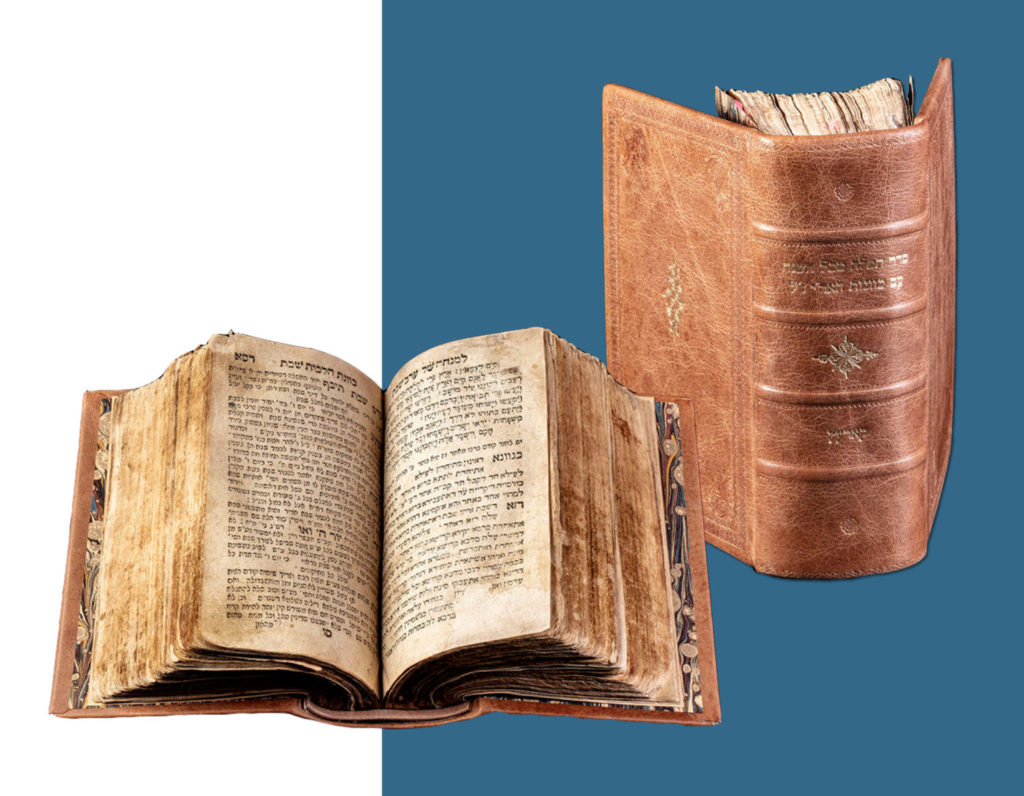
Seder Tefillah L’Chol HaShanah im Kavanot HeAr”i – siddur in nusach Sephard with the Ar”i’s intentions and customs, intentions and unifications from the G-dly Ba’al Shem Tov, with “Dikdukei Sofrim” by the gaon Rabbi Shabtai of Rashkov, Koritz, 1794. First edition of Siddur Rabi Shabtai . Lacking 5 leaves.
Before us is the first edition of this rare and sought-after siddur, with all the sections, prayers for festivals and the Passover haggadah, and with high holiday prayers. With the rare leaf containing Hodu for the eve of Shabbat, and K’Gavna.
This is the first Chassidic siddur! Just a few years after printing this siddur, siddurim began to be printed in an Askenazic version with the Ar”i’s intentions, and Chassidic tzaddikim began to pray from those. However, this is the first siddur in nusach Sephard that has unifications and customs from the Ba’al Shem Tov added to it.
Rabbi Shabtai of Rashkov, the renowned Kabbalist who was one of the members of the Ba’al Shem Tov’s “heichal, ” arranged the siddur according to the Ar”i’s intentions and with supplements from the Ba’al Shem Tov.
This siddur has the recital of Hodu (Psalm 107) before the minchah prayer preceding Shabbat. The Ba’al shem Tov established this custom. It became well-known from the book Me’or Einayim (parashat BeShalach) by the maggid of Chernobyl, disciple of the Ba’al Shem Tov. However, the book Me’or Einayim was published in 1798, and this siddur was published already in 1794.
After the weekday prayers in this siddur, and before the Shabbat prayers [between leaf 263 and leaf 261], there is an unnumbered leaf with Psalm 107, and K’Gavna from the Zohar for Kabbalat Shabbat. The Bibliography of the Hebrew Book notes that this leaf was added to only some of the copies, and the copy they had contained this leaf only in photocopy. Although K’Gavna had been printed earlier, (in Siddur Rabbi Asher in 1788) the custom of reciting Hodu before the onset of Shabbat appeared here for the first time. As mentioned, this rare leaf is found in the copy before us.
Indeed, this siddur was very sought-after by tzaddikm, and even before it was printed, it was known and many yearned to pray from it. As the Ba’al Shem Tov’s disciple, Rabbi Yosef Moshe of Mezeritch, wrote in his approbation to this siddur, ‘I have already heard that many complete and reverent tzaddikim of our generation desire and yearn to quench their thirst and finally see this siddur, because it is so hard to find, especially as it contains several innovations and unifications from my rabbi and teacher, the light of the Jewish people … the Ba’al Shem Tov, ztzllh”h.’
We will note what has been brought, that Rabbi Yisrael of Ruzhin said that this siddur is his vitality. It is also related among Chassidim that the siddur’s manuscript was hidden in a lit oven and did not burn. [Refer to Magdil Yeshuot page 70, and Even Shetiyah HeChadash II page 448.]
Kabbalistic diagrams.
LaMenatzeach Psalm in the form of a menorah on leaf 17 and on leaf 39 in the second page count.
Stefansky, Chassidut 426.
The complete siddur contains: 2, 263 [should be 260] [1] 261-344, 62, 99 leaves.
The copy before us is completed with a professionally photocopied title page. The leaf of approbations and the following leaf, leaf 305 and leaf 308 are lacking. A total of 5 leaves are lacking.
17 cm.
Stamps: on leaf 333, and on leaf 48 in the third page count.
Moderate condition. Many usage marks. Stickers to reinforce several leaves. New leather binding.
Pay Attention: VAT should be added to the commission for foreign residents as well.

Likkutei Mohara”n , Rabbi Nachman of Breslov’s doctrine. Both parts together. The edition before us is actually the conclusive edition of
Likkutei Mohara”n , according to which the hundreds of later editions were printed. In this edition, the two parts were printed together as a complete book; it was also printed with an expanded introduction containing more details that were not in the first edition preceding it; as well as leaves of approbations from rabbinic leaders of the generation, the “Beit Ephraim” and others, appear here for the first time; as well as references which were not printed in the first edition. Breslov, 1821. Rare book, especially in such beautiful condition.
Leaf 2 (in Part I) bears a lengthy handwritten gloss from the period of the book’s printing, possibly in the hand of Rabbi Avraham of Tulchin, renowned disciple of Rabbi Natan of Breslov.
Moharana” t of Breslov was Rabbi Natan Sternholtz of Nemirov [1740-1845], senior disciple of Rabbi Nachman of Breslov. He printed this edition in his underground press at his home in Breslov, for fear of the authorities, because this printing was without the censor’s permit. This is also the reason that the book’s title pages prominently indicate that was printed, as it were, in Ostroh and in Mohilev, respectively, but both parts were actually printed together in Breslov. Rabbi Natan of Breslov writes of himself in the book’s foreword: “I started setting up the press in my home in 1819 in order to reprint his holy books with several wondrous corrections, and I had many struggles with it, innumerable tremendous obstacles. And with His wondrous salvation, Hash-m desired its success and I finished it in three years, that is, from 1819 through the end of 1821, when the printing of
Likkutei Mohara”n HaRishon V’Tanina was completed.”
Two parts: 4, 122, [1]; [1] 44 leaves. 24 cm. Bluish and greenish paper. In the copy before us, the table of contents for the first part is bound at the end of the second part. Stefansky,
Chassidut 287.
Fine condition. Aging stains. Professionally restored. Completion of white margins in the first title page and in several leaves. Leaves 42 and 43 in the second part bear a small professional completion of text using leaves from a different copy. New semi-leather binding.
Pay Attention: VAT should be added to the commission for foreign residents as well.
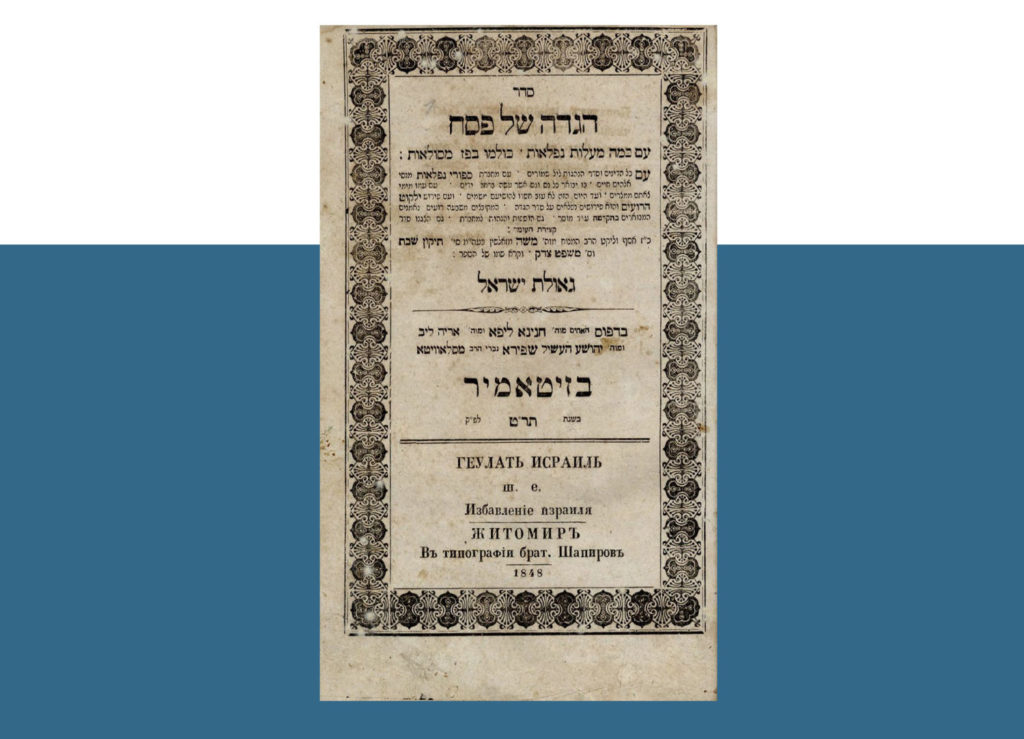
Seder Haggadah shel Pesach – Geulat Yisrael by Rabbi Moshe of Zolshin, at the press of the brothers Rabbi Chanina Lipa, Rabbi Aryeh Leib and Rabbi Yehoshua Heschel Shapira, grandsons of the rabbi of Slavuta. Zhitomir, 1848. Exceptionally rare Chassidic haggadah, especially fully complete.
On the title page: Including the order of customs for Leil Shimurim and the “Yalkut HaRo’im” commentary, and including a booklet of tales of wonders. Anthologized and compiled by Rabbi Moshe of Zolshin.
Rabbi Moshe of Zaloshin was one of the leading disciples of the seer of Lublin, who attested about him that from the age of ten, he dedicated himself to Hash-m. He was very particular to recite Tikkun Chatzot. It is told that at his daughter’s wedding, he left the gathering; people searched for him, and found him in the synagogue reciting Tikkun Chatzot. He also authored Mishpat Tzeddek on Psalms and Tikkunei Shabbat on prayer. All his writings have been very accepted throughout generations of Chassidim.
Passover haggadah printed in sanctity by the rabbinic brothers of the Shapira family.
Handwritten customs and supplements have been added along the leaves of the haggadah.
Ya’ari 682; Otzar HaHaggadot 927.
71 pp, 19.5 cm. Fine-very fine condition. Minimal aging stains. Minimal worming perforations, professionally restored. New binding.

Arvei Nachal – sermons on the Torah per Chassidic foundations, by the Admo”r Rabbi David Shlomo Eibeschutz. Known by the name of his book, as the author of
Arvei Nacha”l . The first edition before us was printed in two variants with very tiny differences between them, and was printed without indication of place nor the year of print. It is commonly accepted that it was printed in Sudilkov, 1825-1826.
Before us is the first edition of one of the fundamental and most important books from the second generation of Chassidism. The book is founded on the Ba’al Shem Tov’s words, whose words, along with his disciples’ words, are often cited in this book. The book is built on lengthy sermons on the weekly Torah portions and the festivals. In the weekly portion Shelach (leaf 77) there is a picture of the splitting of the Red Sea, with the walking routes of the 12 tribes.
Rabbi David Shlomo Eibeshutz [1855-1914] was one of the leading Admo”rs of his generation. He belonged to the group of disciples of Rabbi Yechiel Michel, “the maggid of Zlotchov, ” and even brought something heard in his name in this book (in the Torah portion “Ki Tisa”). He was a friend of many of the rabbinic leaders of his generation: Rabbi Ya’akov Shimshon of Shepetovka, Rabbi Baruch of Medzhibuzh, Rabbi Avraham Yehoshua Heschel of Apta, author of
Kedushat Levi , who wrote about him in his approbation for
Levushei Sarad , “Sharp and expert in the realms of Torah as one of the first; all his actions are for the sake of Heav-n. He dove into mighty waters down to the depths of halachah.” The author of
Be’er Mayim Chaim writes in his approbation there, “The Torah light of the honorable rabbi, the gaon, the great eagle, the illuminating candle, the glory of the Jewish people … and I saw that the book’s words are the lights that illuminate and shine in every direction and into every corner.” In 1808, he ascended to the Land of Israel and settled in Safed, where he passed away. His grave in the cave of tzaddikim in Safed, beside that of the “Bat Ayin, ” became a pilgrimage site, known primarily as a tried-and-true segulah for salvation in finding one’s match. The author chose the name
Arvei Nachal in his lifetime, but the intent in his choice of this name is unclear. He merited that
Levushei Sarad in halachah and
Arvei Nachal on Chassidut became very well-known.
[Part I]: Bereishit-Shemot. [2], 98 leaves; Vayikra. 41 leaves.
[Part II]: Bamidbar-Devarim. [1] 43- 168 leaves.
22 cm; fine condition. Aging stains. Minor Worming perforations. Tiny tears in the margins of several leaves, some restored, with minimal damage to text. Light restoration to the margins of the title pages. New semi-leather bindings.
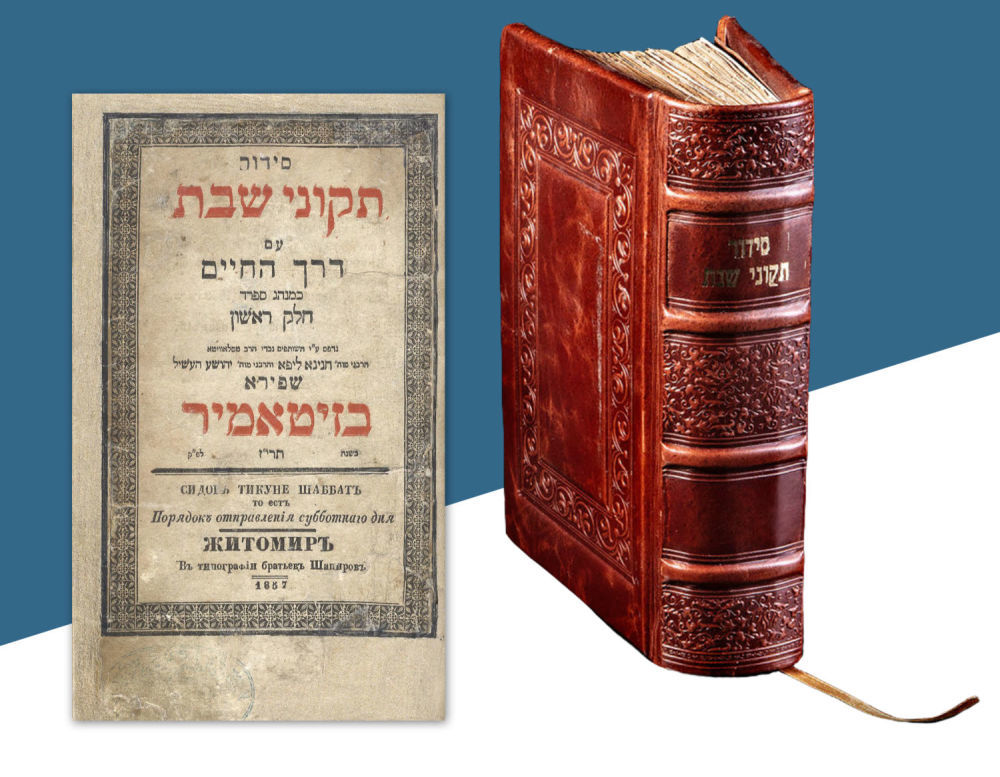
Siddur Tikkunei Shabbat – nusach Sephard, two parts in one volume. Siddur printed in sanctity and purity at the press of the partners, the grandsons of the rabbi of Slavuta, Rabbis Chanina Lipa and Yehoshua Heschel Shapira. Zhitomir, 1857. Especially rare siddur. Without lack.
This siddur is comprised of prayers for the entire annual cycle: Weekdays; Shabbats; the high holidays and the festivals; the Passover haggadah; the service of counting the Omer; Selichot; Yotzrot and more. “With an anthology of sayings by the Sages on repentance and prayer, collected from the most lofty sources by Rabbi Moshe of Zaloshin, and with
Derech HaChaim by Rabbi Ya’akov of Lissa.”
The first part has two title pages, the first of which is in red and black ink. There is an additional title page for the second part.
Part I: [4], 228 pp. Part II: 247 pp. 19 cm. Quality paper.
Fine condition. Professional restoration to the margins of the title pages and several additional leaves. Characteristic wine stains in the Passover haggadah. The top margins are cropped. Magnificent leather binding.
Pay Attention: VAT should be added to the commission for foreign residents as well.
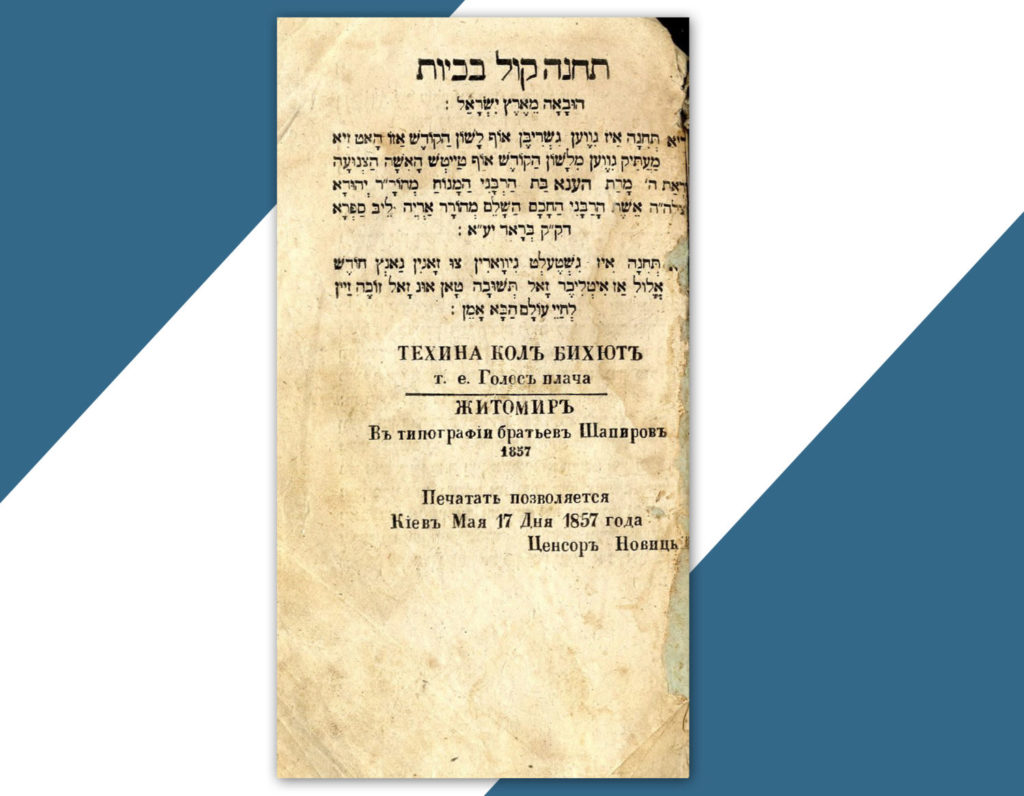
Techinah Kol Bechiyot , brought from the Land of Israel. Supplication originally in Hebrew and designated to be recited in the month of Elul. Translation by Mrs. Henna, wife of Rabbi Aryeh Leib Safra of Brod. Printed by the Shapira brothers. Zhitomir, 1857.
The title page bears the place and names of the printers in Russian only. The
Techinah is not listed by the
Bibliography of the Hebrew Book and does not appear in the National Library’s collection.
As is known, books that were printed at the presses in Slavuta and in Zhitomir by the Shapira family, sons and grandsons of Rabbi Pinchas of Koritz, are known to have additional sanctity. They are considered segulah books, especially books of Tehillim and techinot, with prayers recited from them considered to be with a segulah to be readily accepted. All the more so this ancient book of
Techinot , possibly the only surviving copy.
14 pp. Leaves of various sizes, as it left the press. Moderate condition. Aging stains. Tears in the upper margins, with damage to individual words. Without a binding.
Bound together with [7] additional Yiddish prayer booklets, published in a similar period, some of which are blemished.
*
Techinah fun Rosh Chodesh Bentchin . Vilna, 1855. *
Techinah Teshuvah Tefillah U’Tzedakah . Vilna, 1858. *
Techinah Sha’arei Teshuvah . Vilna, 1853. *
Techinah Shalosh She’arim . Vilna, 1859.
*
Techinah Imahot . Vilna, 1859. *
Sefer Tefillah Zakah by the author of
Chayyei Adam . Vilna, 1857.
*
Mikra Kodesh . Leaves 5-16. The beginning is lacking. Vilna? 1878?.
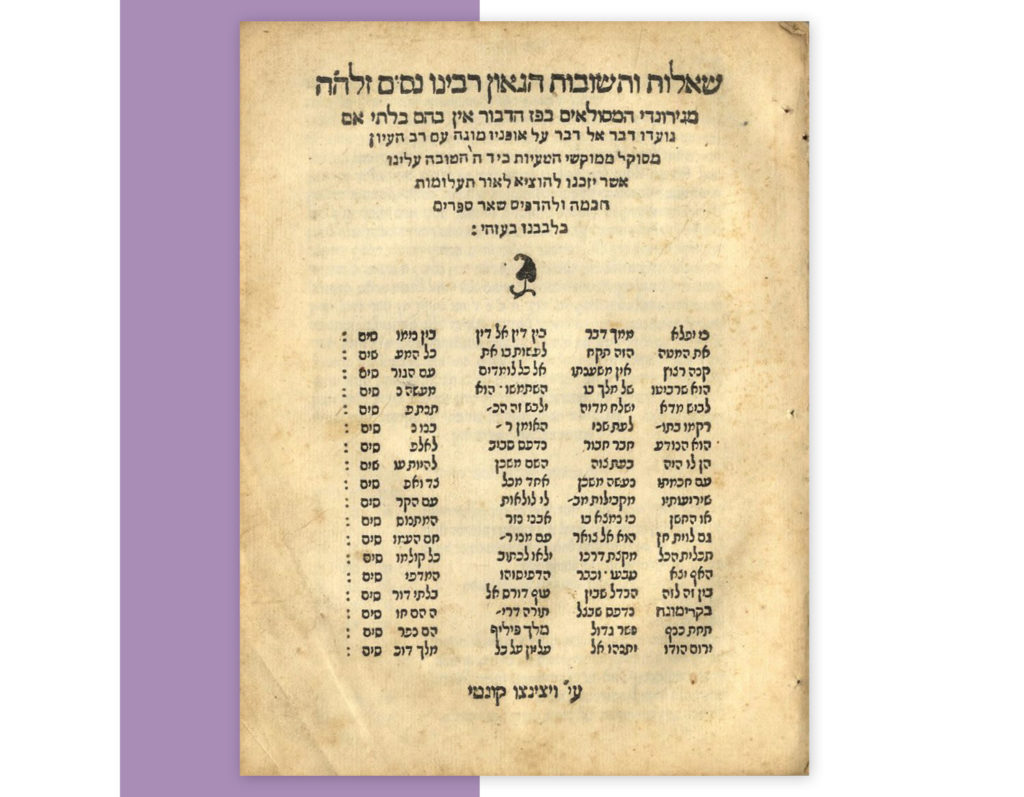
Responsa by the gaon Rabbi Nissim zlh”h of Girondi, one of the prominent Early Authorities, accepted among the commentators of the Ri”f and as one of the leading Talmudic commentators.
Refer to the Hebrew catalog text for a brief biography of Rabbi Nissim son of Rabbi Reuven Girondi, known as the Ra”n .
76 leaves, 18 cm.
Fine condition. Aging stains. Lacking front binding.
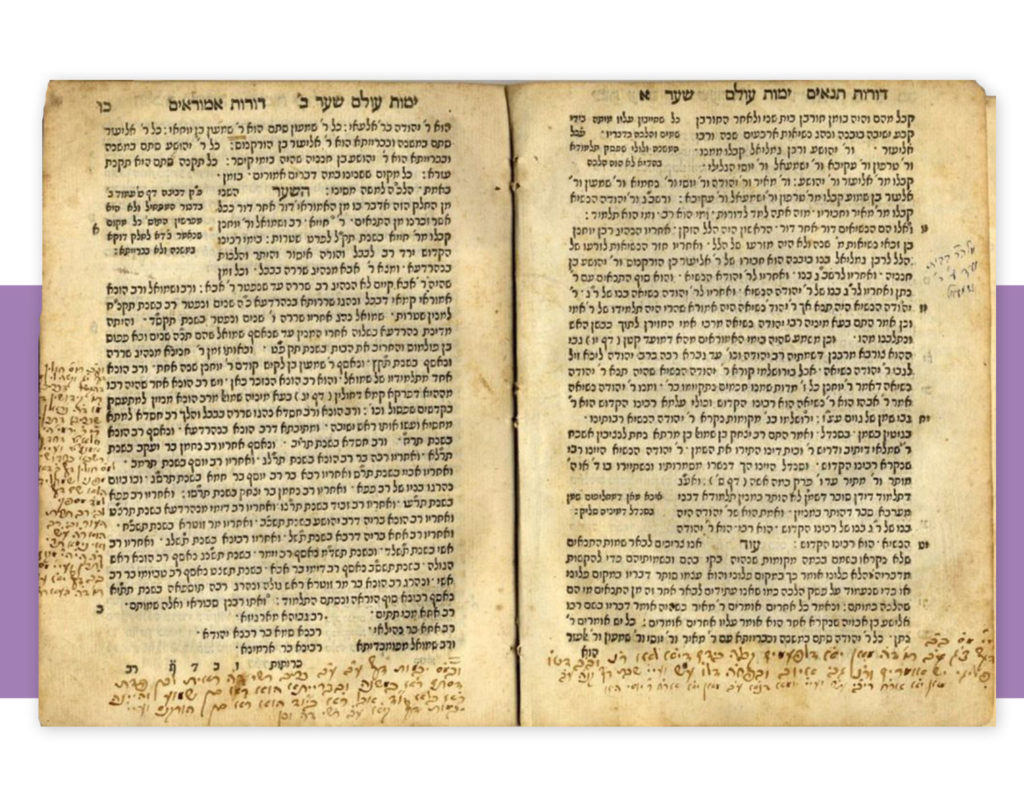
Sefer Kritut , Talmudic rules by the Ra”sh of Kinon. Vincento Kunti Press, Crimea, 1557. Second edition with revisions. The printer writes on the title page that the first edition (Constantinople 1516) was faulty and in this edition “we have separated the wheat from the chaff.”
Ancient owner’s signature of the gaon Rabbi Ya’akov Tzvi of Broide and many glosses by him, as well as an owner’s signature of the gaon Rabbi Menachem Mendel Deutch.
Sefer Kritut was accepted among scholars and printed numerous times, becoming a foundation for later rule-books. Its name, Sefer Kritut , an expression used biblically to indicate a get (divorce document), is borrowed here to express making a covenant with the Torah: “See this book; it is entirely precious / A covenant of love with G-d’s religion / Forever sold to your hearts / So it shall be called Sefer Kritut. ”
Refer to the Hebrew catalog text for a brief biography of Rabbi Shimshon Ben Yitzchak of Kinon, known as Ra”sh MiKinon .
73 leaves. 20 cm. Light, high-quality paper.
Fine condition. Aging stains. Tears in the margins of the title page without lack to text. Reinforcements. Several detached leaves. Not bound.
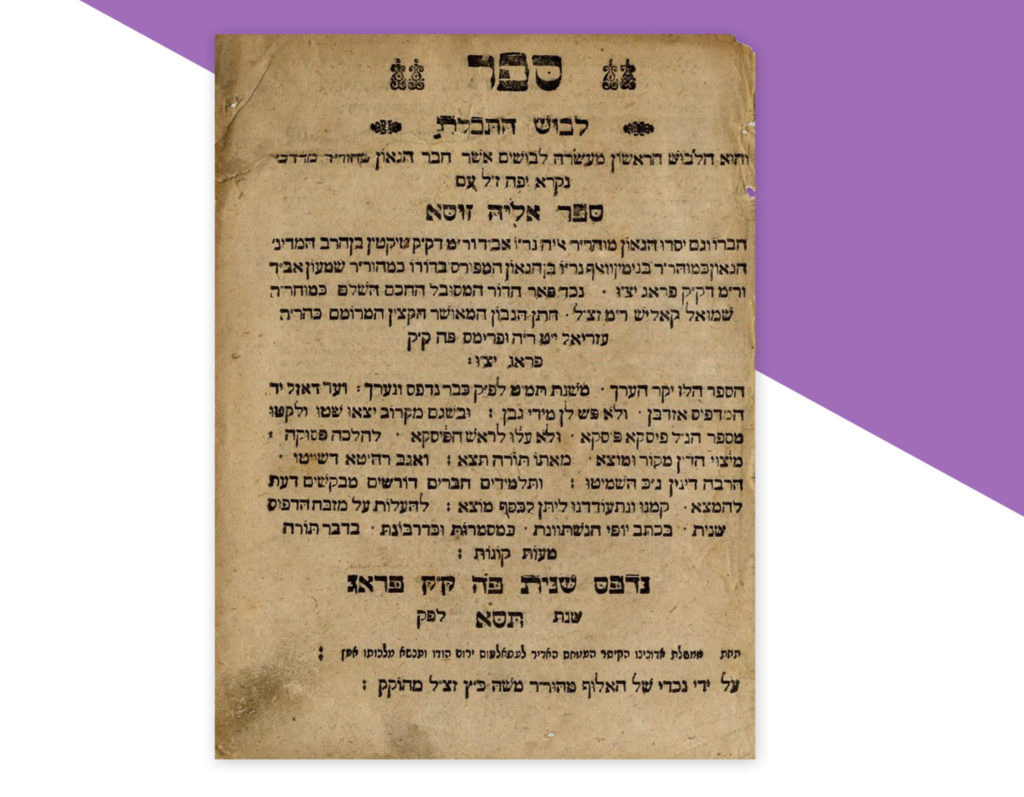
Levush HaTechelet [with Levush HaChur ] by Rabbi Mordechai Jaffe, with Elya Zuta by Rabbi Elya of Tiktin, Prague, 1701. Two parts in one volume.
* Levush HaTechelet [from Tur Ohr HaChaim simanim 1-241]. [2], 108 leaves.
* Levush HaChur [from Tur Ohr HaChaim simanim 242-697]. 109-336 leaves. Mispaginated.
Levush HaTechelet is the first Levush of ten Levushim written by the Ba’al Ha Levushim , and Levush HaChur is the second Levush of the ten Levushim . Before us is an early edition of the Levush with the entire Shulchan Aruch Ohr HaChaim, and with Eliyah Zuta. There are individual copies bound as two separate books that contain an additional title page for Levush HaChur .
Refer to the Hebrew catalog text for a brief biography of Rabbi Mordechai Jaffe .
20 cm. Fine condition. Aging stains. Single leaves are torn from the binding. Tear without lack in the title page and the following leaf. Antique leather binding, blemished and partially lacking.
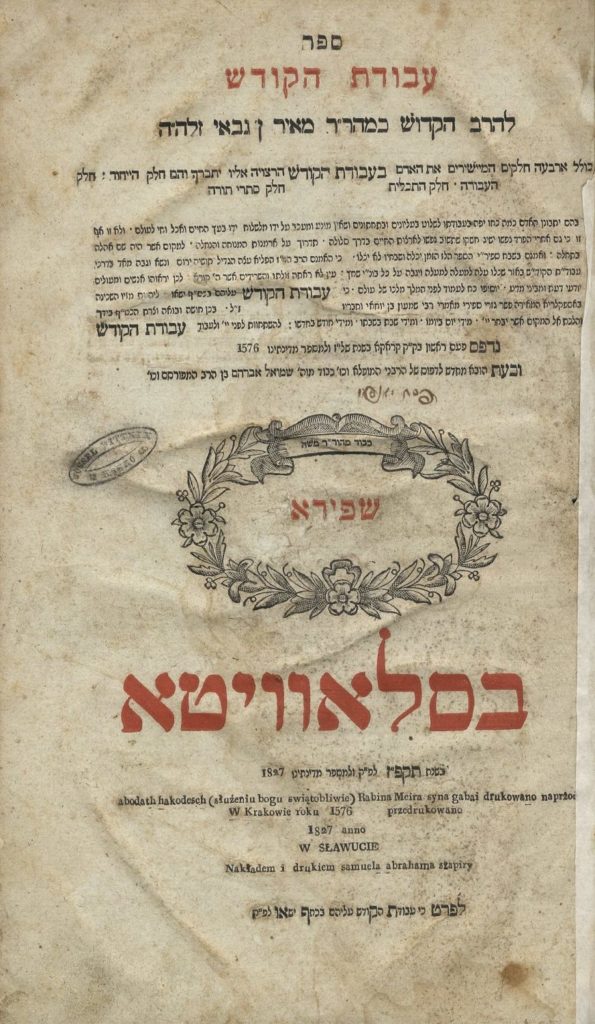
Avodat HaKodesh by Rabbi Meir ibn Gabbai printed by Rabbi Shmuel Avraham son of Rabbi Moshe Shapira. Copies in the condition of this one before us are rare.
Kabbalistic book printed in sanctity by Rabbi Shmuel Avraham Shapira of Slavuta. With approbations by the geonim: Rabbi Chaim HaKohen Rapoport of Ostroh, Rabbi Avraham Abele, Ra’avad of Vilna and Rabbi Shlomo Zalman Av Beit Din of Neishtat-Sigend. We will point out that the rabbinic leaders of Lithuania praise the Chassidic printers in an uncommon manner: “The famous Chassidic rabbi, son of the holy Rabbi Moshe Shapira Av Beit Din of Slavuta.”
72, 20, leaves. 34 cm. Bluish paper. Glosses. Beautiful copy.
Fine condition. Minimal stains.
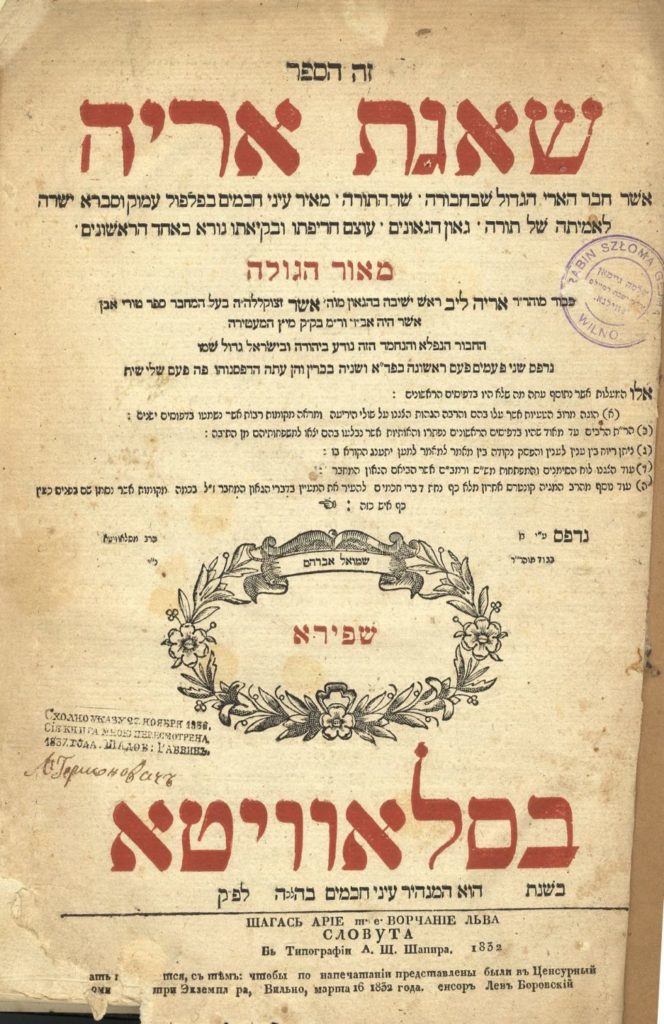
Sha’agat Aryeh – responsa and in-depth studies by the gaon Rabbi Aryeh Leib Ginsburg [1695-1785], rabbi of Metz. Printed by the rabbi of Slavuta, Rabbi Shmuel Avraham Shapira. Copy that belonged to the gaon Rabbi Shlomo Heiman, many stamps.
Before us is the famous monumental work by the author; he is known by its name, as “the Sha’agat Aryeh.” With “Hagahot Chadashot” and “Kuntress Acharon” by the proofreader Rabbi Moshe Aryeh Leib of Vilna. Many approbations from leading rabbis of Lithuania, given specifically for this edition and for “Kuntress Acharon.”
The book Sha’agat Aryeh is considered the epitome of genius and logic, and until the previous generation, it had been customary that almost all bar-mitzvah speeches were drawn from the words of the ‘Sha’agat Aryeh.’
The gaon Rabbi Shlomo Heiman [1892-1945] was one of the leading rashei yeshivah in Lithuania and then in the United States. He was the rosh yeshivah of Ohel Torah in Baranovich and at Yeshivat Ramailes in Vilna. He then moved to the United States where he served as rosh yeshivah of Torah Vodaath in New York, and as a member of the Council of Torah Sages. His novellae were printed by Rabbi Michel Yehudah Lefkowitz, rosh yeshivah of Ponovezh, who was his disciple at the Ramailes yeshivah, in two volumes entitled Chiddushei Rebbi Shlomo , as well as in Shiurei Rebbe Shlomo , which was printed in Lakewood.
2, 90 leaves. 33 cm. Some of the text in the title page is in red ink.
Fine condition. Tear in the margins of the title page with slight damage to text in the Cyrillic letters. Tears in the margins of the first two leaves without damage to text. Slight tear in the last leaf. Simple binding.
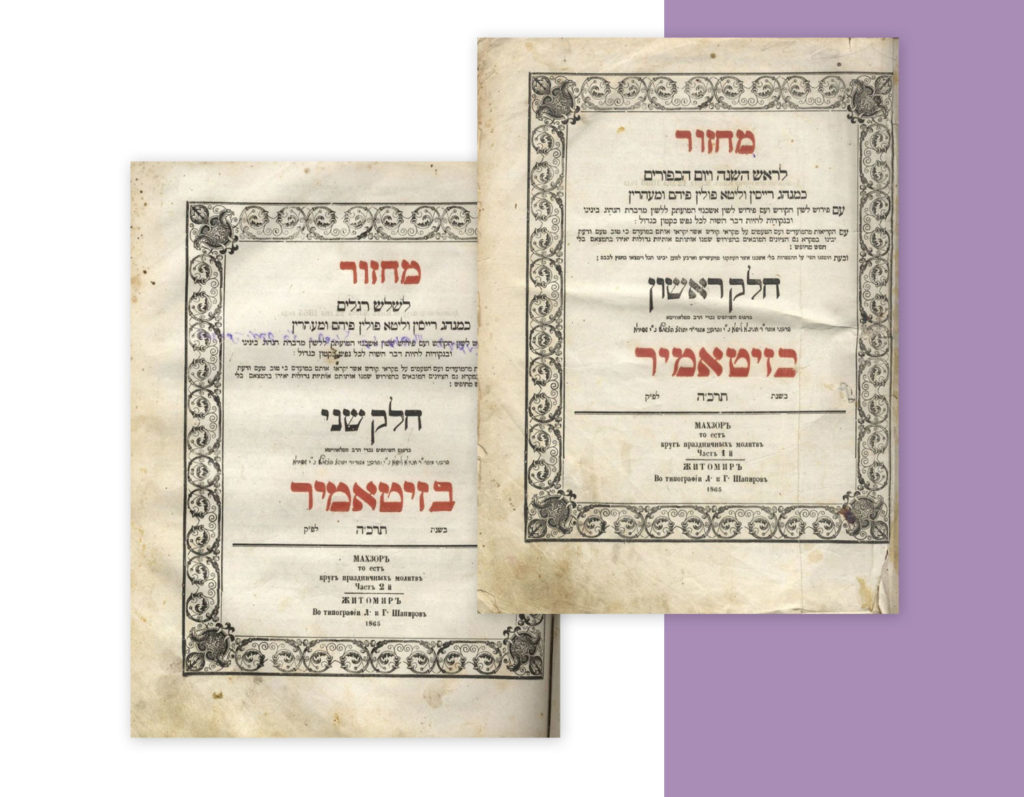
Machzor for Rosh HaShanah, and Machzor for the three pilgrimage festivals, at the press of the rabbi of Slavuta’s grandsons, Rabbi Chanina Lipa and Rabbi Yehoshua Heschel Shapira. Zhitomir, 1865. Two parts.
“With Hebrew commentary and German commentary transcribed into the spoken language.” With Zodiac illustrations in the prayers for rain and for dew. Beautiful set of machzors printed in sanctity by the rabbis of the Shapira family in Slavuta. Admo”rs and early Chassidim would be particular to recite high holiday prayers from machzorim that were printed at the Slavuta and Zhitomir presses as a segulah that their prayers be willingly accepted.
Part I: 508 pp, 28 cm. Part II: 275 pp, 28 cm.
The two parts are bound together in the original leather binding, with imprint. Owner’s signature.
Fine condition. Aging stains. Perforation on the first title page without damage to text.

Machzor for the three pilgrimage festivals, at the press of the partners, grandsons of the rabbi of Slavuta, Rabbis Chanina Lipa and Yehoshua Heschel Shapira. Ashkenaz text. Zhitomir, 1860.
“With pleasant … commentaries … Mateh Levi … Beit Levi … Ma’aseh Arag, and all will be called together “Korban Aharon.” With illustrations of the Zodiac on the prayers for rain and dew. Some of the title page is in red ink. Beautiful machzor printed in sanctity by the rabbis of the Shapira family of Slavuta.
330 pp, 27 cm. Mispaginated. Rabbinic owners’ signatures among the leaves of the machzor.
Moderate-fine condition. Aging stains. Worming perforations. The binding and some of the leaves are detached and reinforced with tape. Restored title page.
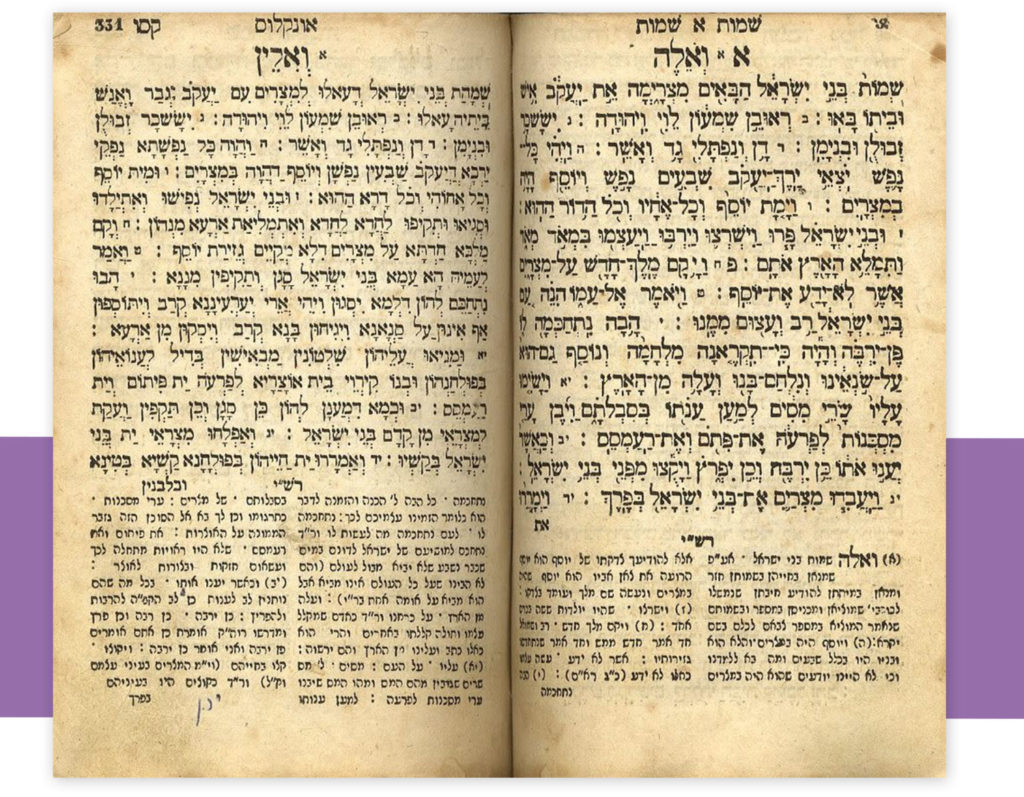
Chumashim Bereishit and Shemot in one volume, printed in sanctity at the renowned Zhitomir press. Incomplete copy.
Lacking title page and approximately the first 16 leaves at the beginning of the book (almost all of the portion of Bereishit), and several leaves at the end of the book in the siddur section (from ‘Nishmat’ onward).
17-327; 15 leaves, 15 cm.
Fine condition. Aging stains. Original binding.
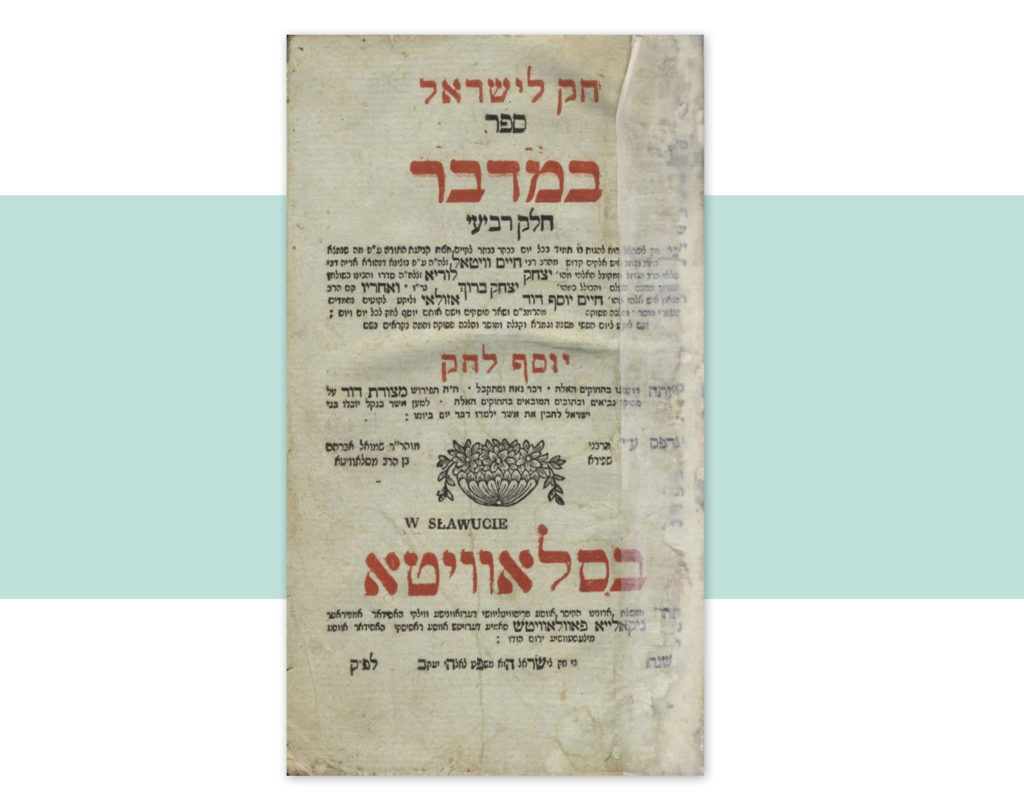
“It is a mitzvah for all Jewish people to buy the book Chok L’Yisrael and read it every day .” (Ma’aseh Rokeach)
Chok L’Yisrael per Rabbi Chaim Vital with Yosef Lekach by the Chid”a. Slavuta, at the press of Rabbi Shmuel Avraham Shapira. Three volumes.
* Shemot: 1832. 258 leaves.
* Vayikra: 1825. 232 leaves. First Slavuta edition.
* Bamidbar: 1832. 230 leaves.
Chumash Shemot bears stamps of Rabbi Yisrael Shimon Shein, one of the leading Chassidim of the Admo”r the Tzemach Tzeddek, one of the founders of the Meah She’arim neighborhood in Jerusalem. He served as the right hand man of rabbinic leaders Shneur Zalman Friedkin, author of
Torat Chessed , and Rabbi Shmuel Salant. He was the grandfather of the Admo”rs of Rachmastrivka.
Chassidic leaders expounded the praise of studying
Chok L’Yisrael daily. The tzaddik of Wilednik wrote the tradition from his rabbis that this is a rectification for the blemish of the covenant [תיקון לפגם הברית] , and the Rebbe of Shinova revealed that it is a segulah for sustenance [שהרי “חק – לישנא דמזוני].
Approximately 19 cm.
Overall fine condition. Minimal tears reinforced with tape. Worming perforations.
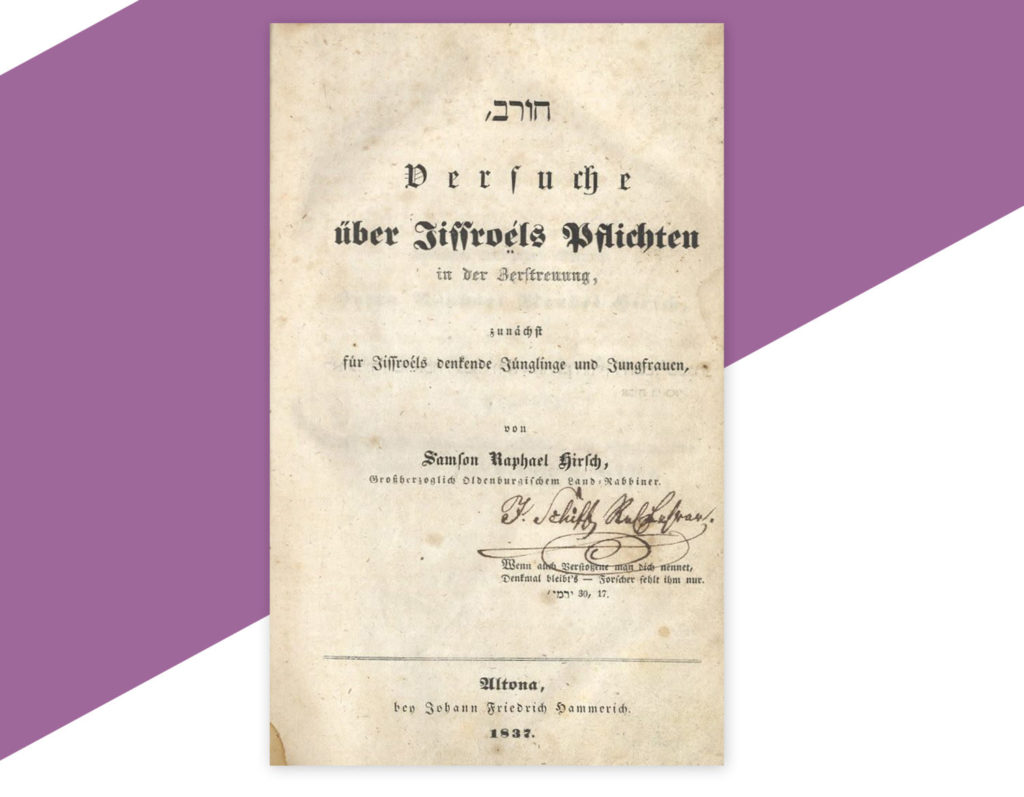
Horeb. The source for each and every mitzvah in the Torah, the reasons for the mitzvahs, and how the reason for the mitzvah can be found in each detail of the mitzvah, through the latest halachic authorities. Rabbi Samson Raphael Hirsch. Altona, 1837. First edition.
800, XVI pp, 20 cm. German.
This is the author’s first work. It was prepared in 1835, when the author was only 27 years old, and still the rabbi of Oldenburg. There was no Jewish publisher willing to take the risk of publishing this great work, given the grim condition of the Jews in Germany. He therefore turned to a non-Jewish publisher in Altona who was unfamiliar with the Jewish market. He too was concerned about his finances, so he asked Rabbi Hirsch to first publish a small compilation as a trial. Therefore, Rabbi Hirsch published his famous book Nineteen Letters on Judaism in Altona in 1836, and given its success, the publisher agreed to publish this work, Horeb , in 1837.
The goal of the book was not to adjudicate practical halachah, but to draw youth to Torah and Jewish tradition, but over time, the book became German Jewry’s “Shulchan Aruch.” The book was written in German at a high literary level, with many quotes in Hebrew. Rabbi Hirsch called his book “an attempt to explain Jewish doctrine.” The book was translated over the years into many languages and editions.
This first edition is extraordinarily rare.
Original cardboard binding, minimally rubbed. Minimal aging stains. Fine-very fine condition.
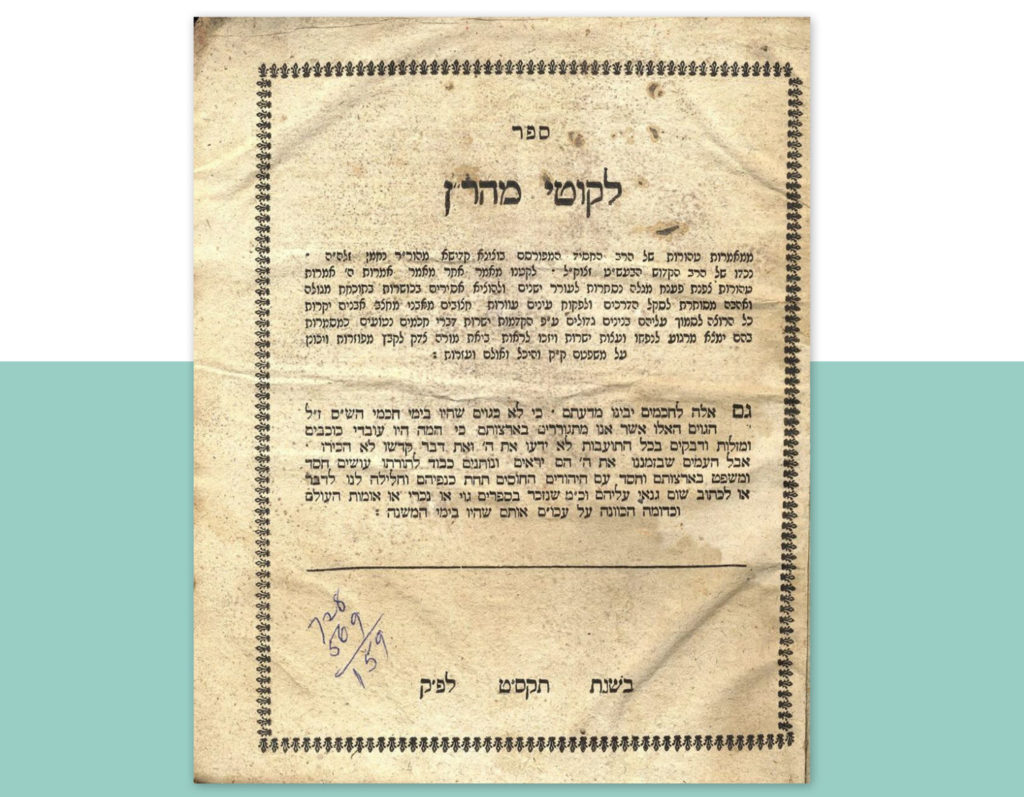
Likkutei Mohara”n by Rabbi Nachman of Breslov. Printed without a place of printing; the year “1809” is written on the title pages. Uncommon book.
Counterfeit edition due to the authorities, as is known regarding the early prints of Likkutei Mohara”n .
The year 1809 printed on the title page is incorrect, as the author is mentioned referencing that he had already passed away, which actually happened in 1811. Refer to the compilation Eleh Shemot , Jerusalem, 1928, p. 14, no. 37 that theorizes the book was printed in Lemberg or in Zolkiew c. 1850. However, Rabbi Nathan Tzvi Kenig, in Neveh Tzaddikim , p. 81, wrote: Lemberg, c. 1830.
[1] 81 leaves. Second part: [1], 29 leaves. 22 cm. Stefansky, Chassidut 285.
Fine-very fine condition. Rabbinic owners’ signatures. Aging stains. Simple binding.
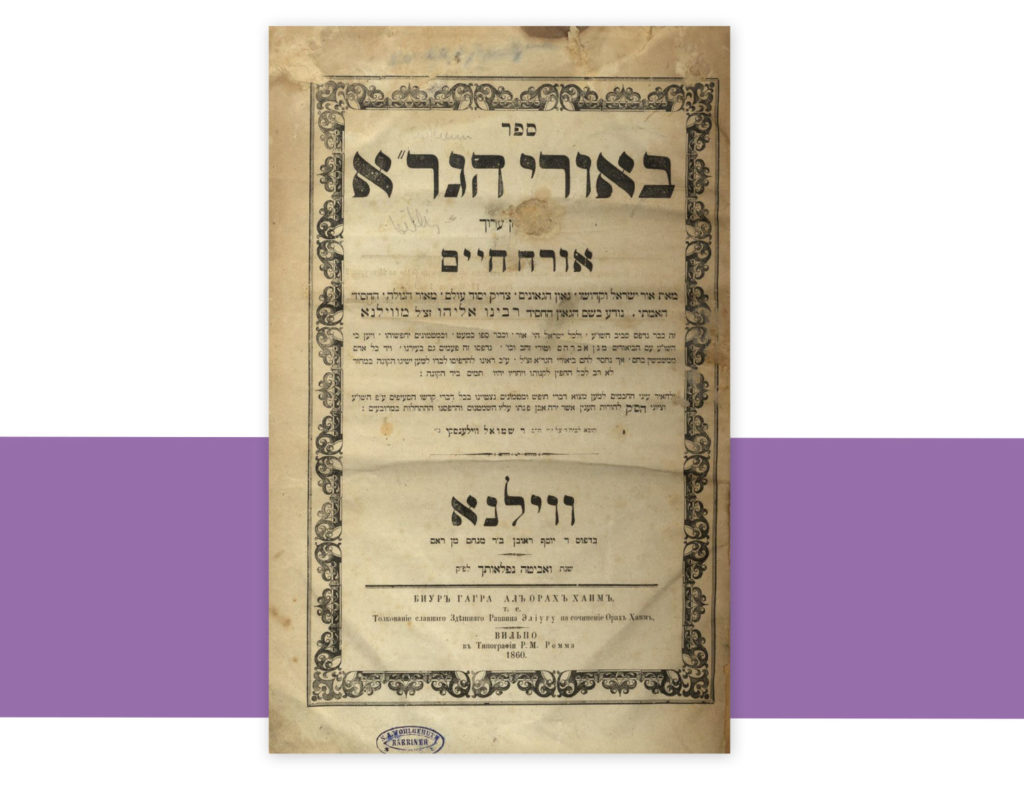
Biurei HaGR”A on Shulchan Aruch Orach Chaim. Special edition in which the GR”A’s elucidations were printed without the Shulchan Aruch.
The person who brought it to print wrote that there are many copies of Shulchan Aruch printed without Biurei HaGR”A , and these are common, so he is printing Biurei HaGR”A on its own. With the introductions and approbations that were printed in the first edition with the Shulchan Aruch.
[4] 55 leaves, 38 cm, Vinograd, Sifrei HaGR”A 748.
Moderate-fine condition.
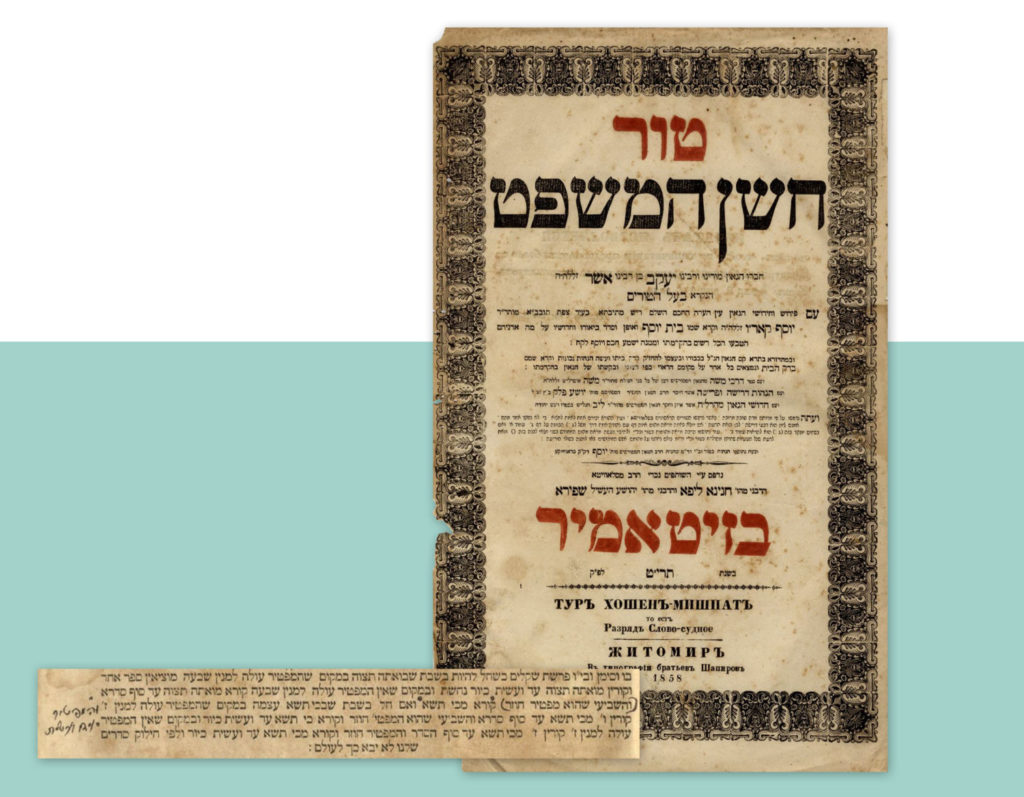
* Tur Orach Chaim im Peirushim … as the first Turim were printed in Slavuta, with supplements. At the press of the rabbinic brothers, Rabbis Chanina Lipa and Yehoshua Heschel Shapira. Zhitomir, 1859. Signatures and gloss.
Large format. Two parts. Title page for each part. [Part I] sections 1-428. [4], 470 pp. [Part II]: sections 429-697. [2]. 274 pp. 34 cm. Fine condition. Aging stains. Minimal worming perforations. Blemishes in the margins of the last leaves, primarily in the two index leaves, damage to isolated words.
* Tur Choshen Mishpat im Perushim … as the first Turim were printed in Slavuta, and with supplements. At the press of the rabbinic brothers, Rabbis Chanina Lipa and Yehoshua Heschel Shapira. Zhitomir, 1859.
Large format. Two parts. Title page for each part. [Part I] sections 1-175. 1858, 428 pp. [Part II]: sections 176-425. [2], 260; 380 [should be 128] pp.
Mispaginated. 33 cm.
Fine condition. Aging stains. Minimal worming perforations. The binding, the title page and the following leaf are all detached.
* Shulchan Aruch Ohr HaChaim im Be’er Heitev V’Eshel Avraham V’Od . Part I. At the press of the rabbinic brothers, Rabbis Chanina Lipa, Aryeh Leib and Yehoshua Heschel Shapira. Zhitomir, 1850.
Small format. Lacking a leaf in the table of contents and possibly also an additional title page at the beginning.
[1] 3-281 leaves, 21.5 cm.
Fine condition. Worming perforations. Aging stains and mold. Tears in the last page without lack to text.
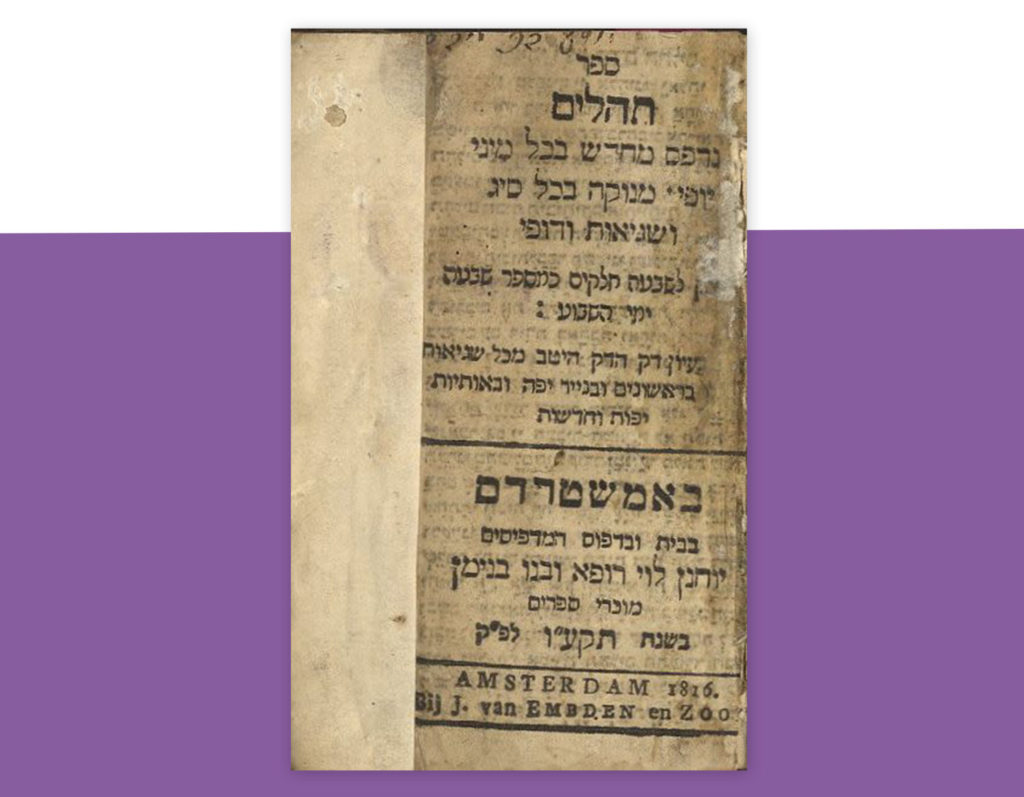
Beautifully reprinted Tehillim … Amsterdam, at the home and press of Yochanan Levi Rofeh and his son, Binyamin. For the Ma’amadot service and the prayers for Yom Kippur Kattan.
The Ma’amadot have a dedicated title page (leaf 73). Leaf 135 onward: Eruv Tavshilin; Vidui L’Shachiv Mera from Shnei Luchot HaBrit , Yom Kippur Kattan prayers, weekday Aravit prayers and supplications for cemeteries.
Especially rare. The Bibliography lists it according to a copy in the National Library, in which a large section of the book is lacking, and also lacks the title page for the Tehillim. However, it records it as part of a siddur (yet no such siddur is known).
161 leaves, approximately 10 cm.
Overall fine-very fine condition except for a blemish in the title page and the final leaf. Minimal aging stains. Original leather binding.
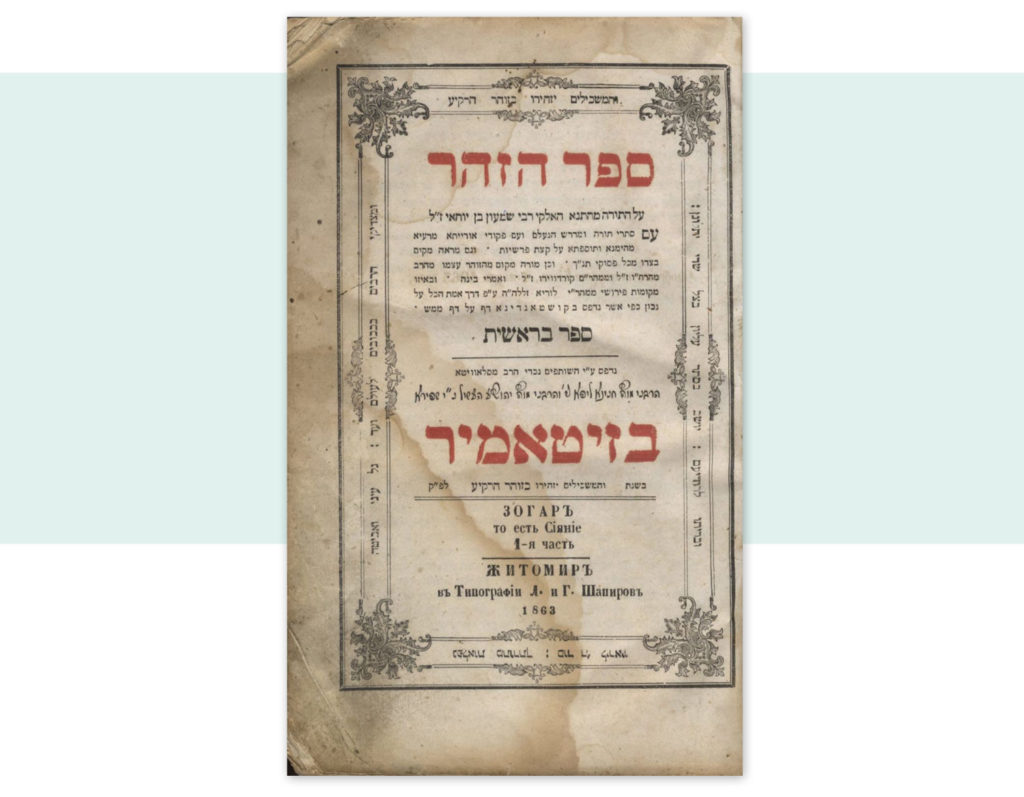
Zohar on Sefer Bereishit. Zhitomir, at the press of the grandsons of the Rabbi of Slavuta, Rabbi Chanina Lipa and Rabbi Yehoshua Heschel Shapira.
With the approbation of the Admo”r Rabbi Aharon of Chernobyl given – for the first time in the edition before us – to his in-law, the printer Rabbi Yehoshua Heschel Shapira.
[4] 251, 16 leaves, 20 cm.
Fine-very fine condition. Aging stains. Isolated worming perforations in the white margins. Simple binding.
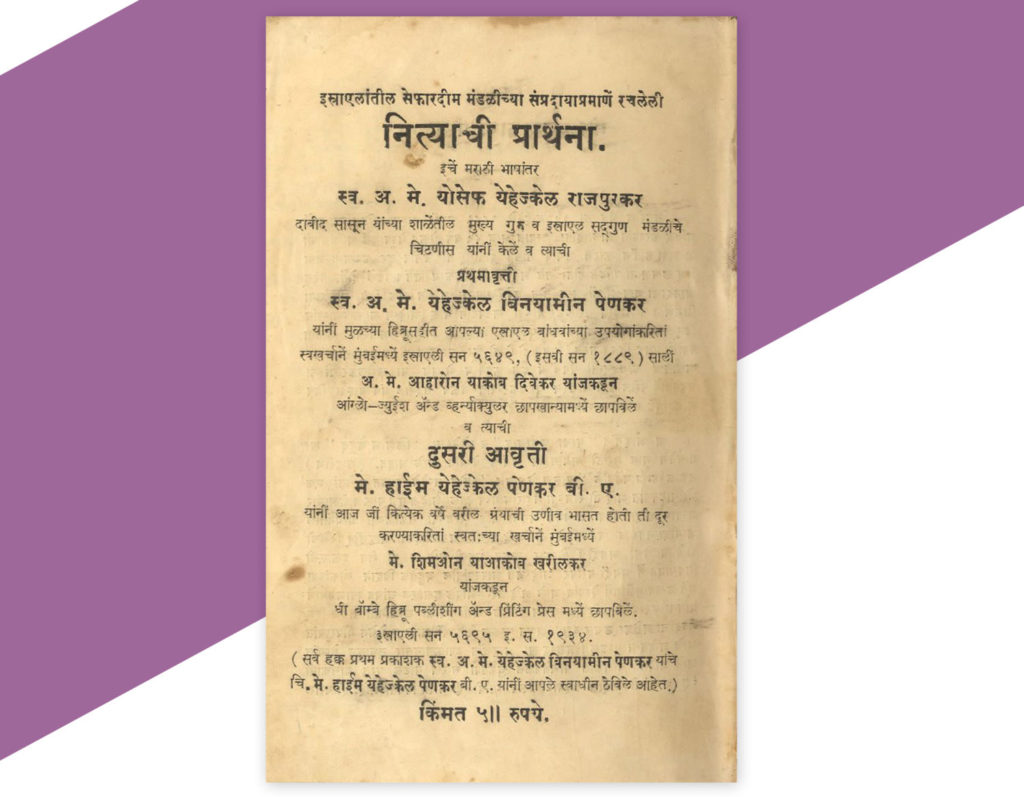
Sefer Tefillat HeChadash. Siddur per the Sephardic custom with Marathi translation. Bombay, The Bombay Hebrew Publishing and Printing Press. 1937.
Siddur for the entire year with Marathi translation by R’ Yosef Yechezkel Ragforcher. The translation is printed on facing pages. Title pages in Hebrew, Marathi and English. Including Kabbalistic customs and prayers.
On page 139 and the page facing it, printed stickers were affixed with corrections to the text. Uncommon siddur.
[10], 380, 380, [2], 17 pp, 21 cm.
Moderate-fine condition. Fabric binding, adhesions and corrections. Aging stains.
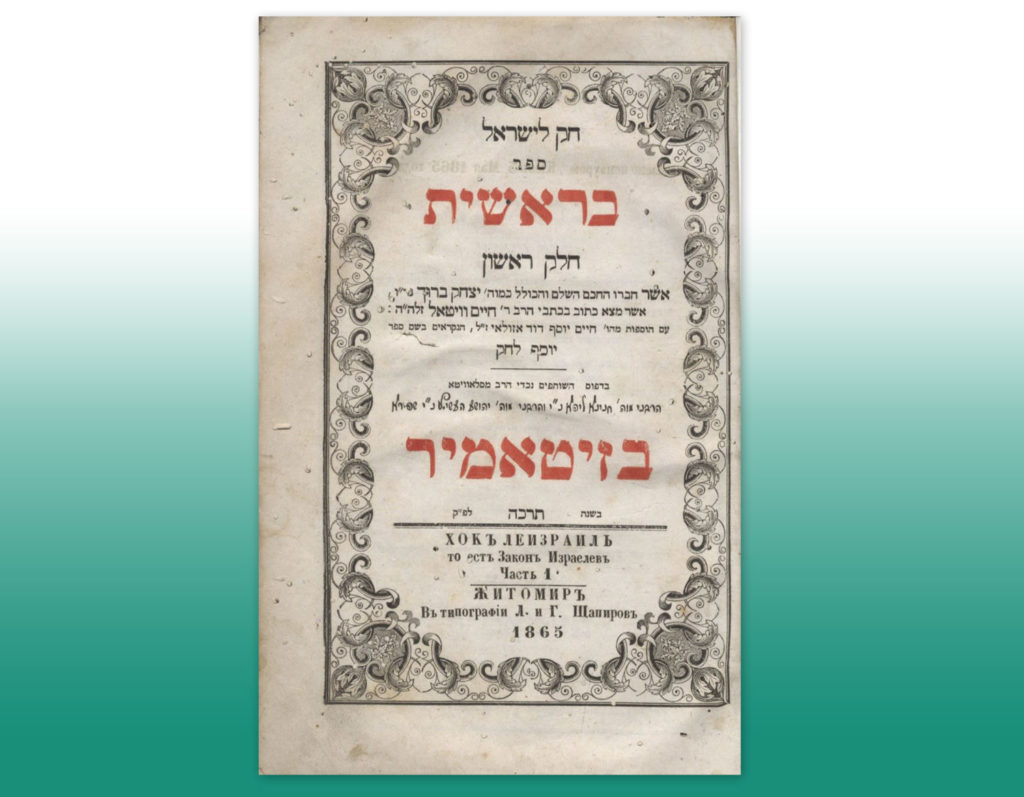
“It is a mitzvah for all Jewish people to buy the book Chok L’Yisrael and read it every day.” (Ma’aseh Rokeach)
Chok L’Yisrael per Rabbi Chaim Vital with Yosef Lekach by the Chid”a. Zhitomir, at the press of the grandsons of the rabbi of Slavuta, Rabbi Chanina Lipa and Rabbi Yehoshua Heschel Shapira. Four volumes.
* Bereishit: 1865. Two title pages. 518 pages. 19.5 cm.
* Shemot: 1865. Two title pages. 488 pages. 19.5 cm.
* Bamidbar: 1865. Two title pages. 452 pages. 19.5 cm.
* Devarim: 1861. Two title pages. 432 [should be: 478] pages. 17.5 cm. Interesting notation on the final page.
The three parts Bereishit, Shemot and Bamidbar, are from one edition, of identical size and bound in similar bindings.
Chassidic leaders expounded the praise of studying Chok L’Yisrael daily. The tzaddik of Wilednik wrote the tradition from his rabbis that this is a rectification for the blemish of the covenant, and the Rebbe of Shinova revealed that it is a segulah for sustenance [שהרי “חק – לישנא דמזוני].
Overall moderate-fine condition. Aging stains. Worming perforations.